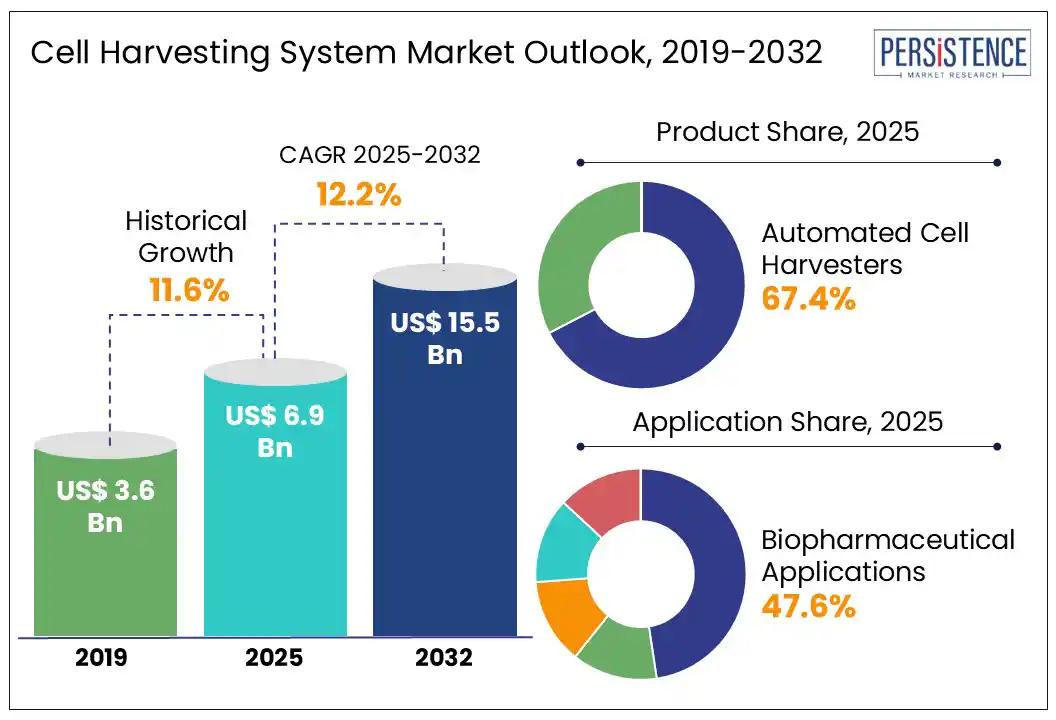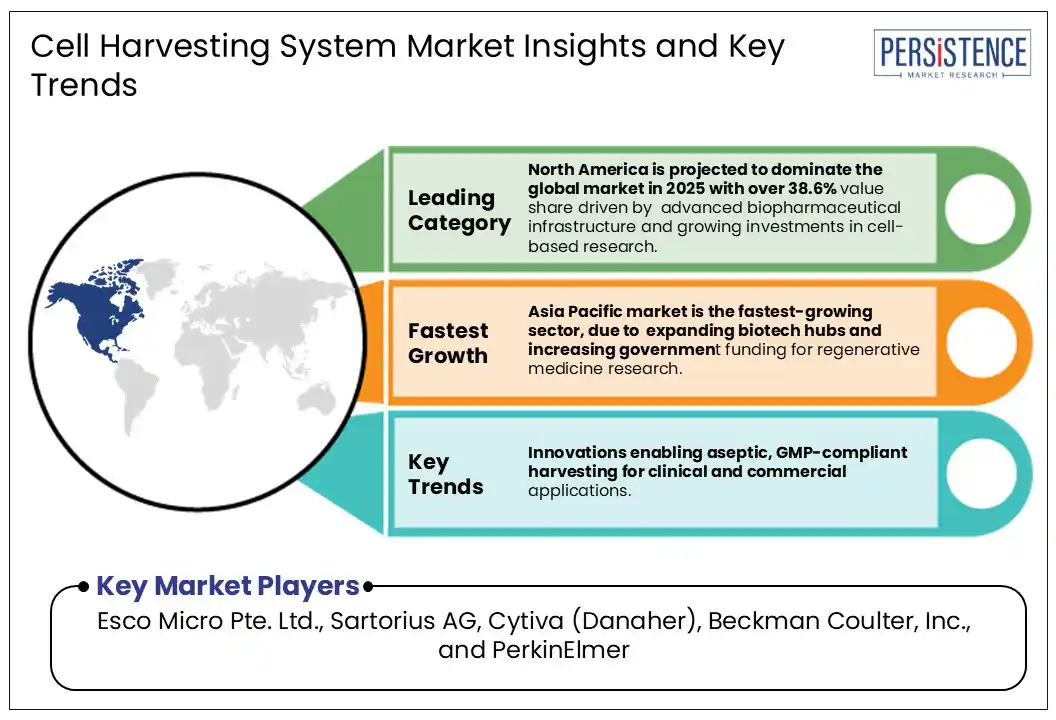ID: PMRREP34752| 195 Pages | 14 Jul 2025 | Format: PDF, Excel, PPT* | Healthcare

The global cell harvesting system market size is likely to be valued at US$ 6.9 Bn in 2025 and is estimated to reach US$ 15.5 Bn by 2032, growing at a CAGR of 12.2% during the forecast period 2025-2032.
Cell harvesting involves isolating target cells from growth media and plays a crucial role in biologic manufacturing. Historically dependent on manual methods such as centrifugation and depth filtration, cell harvesting has undergone a technological transformation with the adoption of automation, streamlining workflows while improving reliability, throughput, and process control.
Rising demand for regenerative medicine, personalized therapies, growing research and development in cell-based treatments, integration with artificial intelligence (AI), and expanding healthcare infrastructure continue to propel innovation and global market growth.

Key Industry Highlights:
|
Global Market Attribute |
Key Insights |
|
Cell Harvesting System Market Size (2025E) |
US$ 6.9 Bn |
|
Market Value Forecast (2032F) |
US$ 15.5 Bn |
|
Projected Growth (CAGR 2025 to 2032) |
12.2% |
|
Historical Market Growth (CAGR 2019 to 2024) |
11.6% |
Advancements in automation and single-use technologies are key drivers of the global cell harvesting system market. Traditionally reliant on manual centrifugation and depth filtration, cell harvesting has evolved with innovations that enhance scalability, reduce variability, and streamline workflows.
For example, in October 2022, Thermo Fisher Scientific launched the DynaSpin Single-Use Centrifuge, which reduces filter use up to six-fold and cuts waste by 70% compared to conventional systems. In May 2024, Cytiva, in collaboration with Kite (Gilead), introduced the modular Sefia cell therapy manufacturing platform. The platform automates key CAR-T cell therapy steps—from isolation to expansion—via closed, digitally integrated systems. These technologies minimize contamination risks and manual intervention while supporting regulatory initiatives such as the FDA’s Emerging Technology Program.
Additionally, advances in automated tangential flow filtration (TFF) and continuous centrifuges further enable real-time monitoring, cost-effective production, and faster turnaround times, positioning automation as a critical force propelling the growth of the global market.
Automated cell harvesting technologies face significant restraints in the global market due to several key factors. First, legacy facilities still rely on manual centrifugation and depth filtration driven by prior capital investments and regulatory comfort with automation adopted unevenly.
Deploying automated systems like TFF or continuous centrifuges requires extensive qualification and process development, often necessitating multiple test runs before defining operational parameters. This slows adoption, especially for new products with limited process data. The high costs of advanced automated equipment and integration compared to manual setups pose budget hurdles. Although, the regulators such as the FDA and EMA support these innovations, uneven uptake across facilities diminishes economies of scale. Together, these factors cost, qualification complexity, and entrenched practices act as a major restraining force.
Advancements in automation and novel cell-harvesting technologies present a substantial opportunity in the cell harvesting system market. Automation in cell culture systems and bioreactor technology plays a critical role in developing pluripotent stem cells for disease modelling and personalized cell therapies.
Automated platforms equipped with robotic arms for liquid and labware handling enable sterile conditions, reduce contamination risks, and maintain optimal cell growth environments in advanced incubators. These systems also help prevent unwanted cell populations and minimize genetic alterations.
In November 2024, Rousselot and IamFluidics introduced a dissolvable microcarrier using patented IN-AIR MICROFLUIDICS™ technology, simplifying adherent cell harvesting and enabling scale-up for therapies and biologics. Devices like AVISO’s CellCelector, an automated cell harvesting device equipped with a robotic arm, further streamline precise, automated cell selection.
Moreover, innovations such as 3D-printed microfluidic systems support continuous stem cell harvesting in large-scale bioprocessing without compromising viability. Integration of AI/ML, and lab-on-a-chip (LOC) solutions continues to optimize yield and scalability positioning the sector for robust growth in regenerative medicine and biomanufacturing.
Automated cell harvesters are projected to capture a dominant revenue share of around 67.4% in 2025. This growth is driven by the superior efficiency, precision, and scalability of automated systems compared to manual systems. Automated systems reduce human error, enhance reproducibility, and allow for high-throughput processing, making them ideal for large-scale applications in research, biotech, and clinical settings. They streamline workflows, minimize labour costs, and accelerate production timelines, catering to the growing demand for advanced cell therapies and personalized medicine. Additionally, technological advancements and increasing investments in automation further drive their adoption, positioning automated cell harvesters as a dominant segment in the cell harvesting system market.
Biopharmaceutical applications are expected to hold a significant revenue share in the global market in 2025. This dominance is due to their critical role in the development and production of advanced therapies, including monoclonal antibodies, vaccines, and cell-based treatments. The biopharmaceutical sector's rapid growth is further driven by increasing investments in research and development, a rising demand for personalized medicine, and advancements in biotechnology. Cell harvesting systems are essential for efficiently processing and purifying therapeutic cells, ensuring high-quality product yields. The expanding focus on innovative treatments for chronic and complex diseases further propels the demand for sophisticated cell harvesting technologies in this sector.

North America is anticipated to dominate the global market in 2025 with a 38.6% value share driven by advanced biopharmaceutical infrastructure and growing investments in cell-based research. The region's leading hospitals, biotech companies, and academic institutions drive high demand for cutting-edge cell harvesting technologies. Robust research collaboration between academia and industry has played a pivotal role in advancing the cell harvesting systems industry, fostering innovation in regenerative medicine, cell therapies, and biomanufacturing technologies. According to survey details provided by the Association of University Technology, over 200 new drugs and vaccines were developed through university-industry partnerships between 1996 and 2020.
Additionally, the number of research grants awarded rose from an average of 7,000 per year (1990–1999) to 9,500 per year (2000–2010). Moreover, U.S.-based small biopharmaceutical companies dominated global R&D rankings in 2021, with 193 of the top 260 firms headquartered in the U.S. and spending an average of $637,735 per employee on R&D. Strong support from government initiatives, favourable regulatory environments, and high adoption rates of automated systems further bolster market growth. Additionally, North America's emphasis on personalized medicine and regenerative therapies fuels the need for efficient, scalable cell harvesting solutions, positioning it as a dominant player in the global market.
Europe is emerging as a major growth hub for the cell harvesting systems market, driven by strong regulatory support and strategic investments in advanced biomanufacturing. Favourable policies, expedited approvals, and research funding have significantly reduced entry barriers and accelerated the adoption of innovative technologies. In May 2023, the Deutsche Forschungsgemeinschaft (DFG) established 11 new Collaborative Research Centres (CRC) to boost research in advanced biomedical fields, reinforcing the region’s R&D capabilities.
By third quarter of 2025, Novartis plans to launch a new GMP-ready cell culture manufacturing line, RPP1-CC, at its Kundl site in Austria. Designed for high-volume biologics production, the site will produce up to 1.7 million litres of cell culture harvest annually using advanced, automated systems.
These developments reflect Europe’s proactive approach in supporting modern cell therapy infrastructure, making it a driving force in the global market through regulatory clarity, innovation funding, and industrial-scale implementation.
Asia Pacific market is rapidly growing, due to expanding biotech hubs and increasing government funding for regenerative medicine research. The region's expanding emphasis on advanced medical research and diagnostics increases the demand for sophisticated cell harvesting technologies.
In December 2023, FUJIFILM Corporation announced a US$200 million investment in FUJIFILM Cellular Dynamics and FUJIFILM Diosynth Biotechnologies to enhance cell therapy CDMO capabilities. This move supports the production of advanced therapies, including iPSC-derived, CAR-T, CTL, TCR, NK, and tissue-based treatments. Increasing research activities in academic and research institutions, coupled with supportive government policies and funding, further stimulate market growth. Additionally, the rising prevalence of chronic diseases and a growing patient population contribute to the expansion of cell-based treatments. Emerging market dynamics and technological advancements make Asia Pacific a key region with substantial growth potential.
The global cell harvesting system market features established players and startups launching innovative automated solutions. Companies drive growth through technological advancements, system integration, and strategic partnerships, mergers, and acquisitions to expand market presence.
The global cell harvesting system market is set to reach US$6.9 Bn in 2025.
The cell harvesting system market is projected to record a CAGR of 12.2% during the forecast period from 2025 to 2032.
Innovations enabling aseptic, GMP-compliant harvesting for clinical and commercial applications are driving the global market.
Esco Micro Pte. Ltd., Sartorius AG, Cytiva (Danaher), Beckman Coulter, Inc., and PerkinElmer are a few leading players.
North America is projected to dominate the global cell harvesting system market in 2025.
|
Report Attribute |
Details |
|
Historical Data/Actuals |
2019 - 2024 |
|
Forecast Period |
2025 - 2032 |
|
Market Analysis Units |
Value: US$ Mn/Bn Volume: Units |
|
Geographical Coverage |
|
|
Segmental Coverage |
|
|
Competitive Analysis |
|
|
Report Highlights |
|
|
Customization and Pricing |
Available upon request |
By Product
By Application
By End-user
By Region
Delivery Timelines
For more information on this report and its delivery timelines please get in touch with our sales team.
About Author